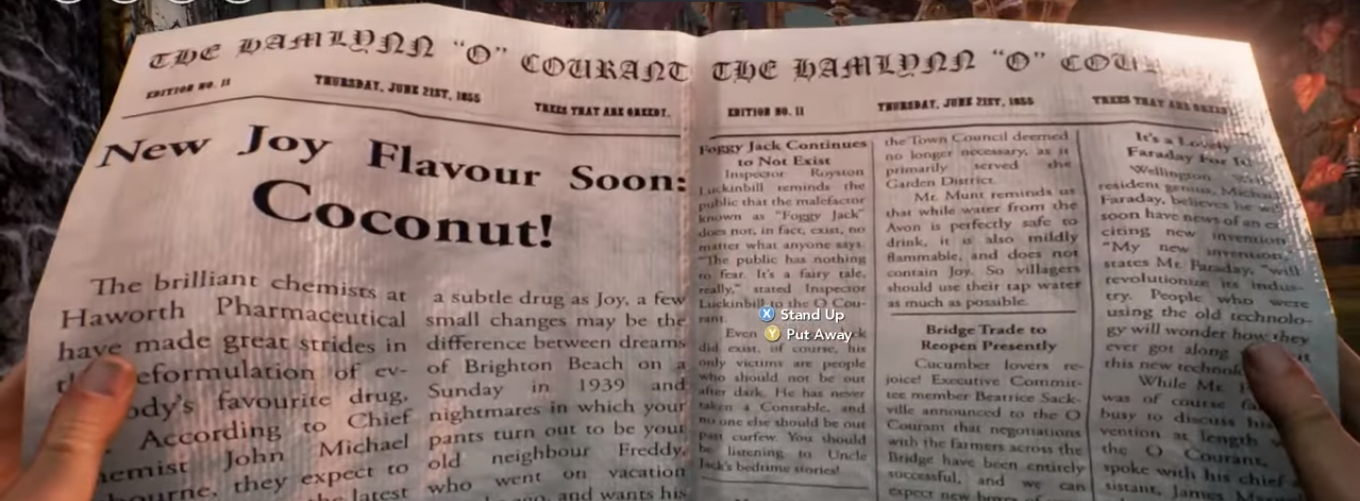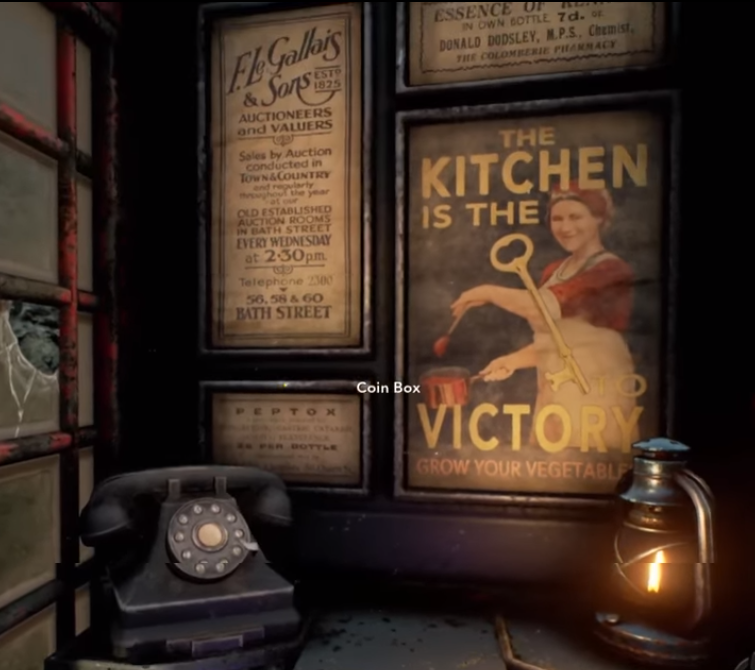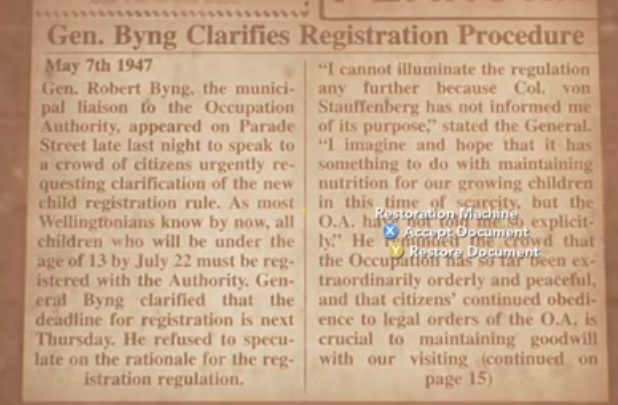Six things You missed in the We Happy Few demo

The We Happy Few demo comes to PC and Xbox Preview on 26 July. It’s one of the creepiest games headed to consoles, but there’s far more to We Happy Few than meets the eye. Saturated with pop culture references, it’s got enough depth to send a scuba diver into rhapsodies. The name We Happy Few alone is a nod to *that* speech in Shakespeare’s Henry V. More specifically, Henry V says that he and those who fight for him, ‘we happy few’, will go up in the world, but then he goes on to say (more or less) that those who aren’t with him are against him. Pretty cutthroat.
But this approach is characteristic of the dystopian world of We Happy Few. Despite Tolstoy’s quote preluding the demo that ‘happy people have no history’, We Happy Few is full of references to history, plays, television shows, fairytales and books. Even the trailer was full of references to zany 60s spy show The Prisoner, finishing on a sneaky "be seeing you!" Each one of these allusions gives us a tiny insight into the dark world of Wellington Wells, and trust me – it’s an unnerving one.
Shakespeare

English history has been having a bit of a renaissance lately. British TV has seen big-budget BBC adaptations in The Hollow Crown and the Cromwellian scheming in Wolf Hall. Game of Thrones is full of Shakespearean politics. It’s no surprise that We Happy Few is the latest to refer to the Bard’s version of our bloody past.
Even if it is through the disturbingly 1984-lens of the Redactor, adverts pop up in the Wellington Wells newspaper advertising Duke of Clarence Malmsey soda. Richard III drowned his brother George, Duke of Clarence, in a vat of Malmsey wine, so the allusion is more than a tad morbid. Especially since the advert chirps ‘Drown the Black Dog in Malmsey!’. Do I want to drink the beverage that symbolises fraternal murder? No thank you. What’s more disturbing is that the powers-that-be in Wellington Wells are using this brotherly betrayal as a selling point.
Doctor Who

In the corner of Arthur’s office sits a bin. Not the most dynamic of props, but I promise I’m going somewhere with this. The bin itself looks like a nod to the Daleks, Doctor Who’s most recognisable villains, with its panelled spherical design. It’s attention to the small things which sets We Happy Few apart.
First appearing on our screens in the ‘60s, the very first series of Doctor Who with William Hartnell fits in with the retro aesthetic of We Happy Few, with its shift dresses, sharp suits and beehives. Doctor Who is famous for its monsters and frequent trips into societies in the middle of being turned upside-down. The monsters in We Happy Few might be of the human variety (despite the smiles plastered across their faces) but the setting is about as topsy-turvy as it gets.
The Pied Piper

A quick recap of the Pied Piper story: rats infest the town of Hamelin, the Pied Piper arrives, draws the rats away with his flute, but when the townsfolk refuse to pay him, he lures away their children as payment. What a charming tale.
Weekly digests, tales from the communities you love, and more
So naturally Wellington Wells calls their newspaper ‘The Hamlynn O Courant’ (Hamlynn, Hamelin; potato, potahto). This isn’t just a throwaway reference. Wandering around the streets, the Wastrels (looking considerably scruffier than their coiffured, clean neighbours in Central Wellington Wells) wail about ‘toys and tiny beds’, and there is a distinct lack of children in Wellington Wells. One of the newspaper stories we catch a glimpse of mentions children having to be registered with the authorities for an unknown reason. Perhaps they’ve been whisked away somewhere just like in the fairytale…
Alice in Wonderland

‘The rabbit has lost his watch.’ The rabbit is probably quite late, in that case. Sound familiar? The fluffy white rodent we all know so well from Alice in Wonderland appears in this coded message that purrs out of one of Wellington Wells’ telephone boxes.
It certainly feels like Arthur has fallen down the rabbit hole in that one memorable scene in particular which features a fleshy rat piñata. Perhaps some of the disgruntled inhabitants of Wellington Wells are only too aware of how similar it is to a dystopian Wonderland. Guillaume Provost, creative director of We Happy Few, has already confirmed that Arthur is only one of the playable characters, so maybe you’ll get the chance to step into the shoes of a rebel (is it too much to hope they’ll be called Alice?) who’ll be using these coded messages.
Arthurian Legend

Next up: King Arthur and his famous round table. One of the knights sitting around his table was Percival, who was brought up to be as ignorant of knights’ etiquette as I am of basket-weaving techniques. Yet when he turned up to King Arthur’s court, turns out he was naturally talented and took to being a knight like a duck to water.
Burying his head in his hands as the world around him turns grey, Arthur begins to remember. The sound of a train pulling away echoes around his ears. A boy calls out for him in the distance. Arthur screams aloud ‘Percy!’. The Percy he’s wailing for is his brother, Percival, mentioned in the fateful article which jogs his memory. Arthur, Percy – I’m sceptical about the likelihood of players encountering someone called Lancelot, but with the first character we’ve seen being called Arthur I don’t think it’s a coincidence that his brother is called Percival. Did Percy run afoul of the authorities as a result of being - much like his namesake - ignorant of acceptable etiquette? There's certainly - potentially - an interesting, thematic parallel there.
It's also interesting to note the very specific number attached to the brothers' scrap-collection feat. 1654 pounds. That's a suspiciously large amount of steel for two boys to gather. Sounds very much like a reference to a date, does it not? 1654 was significant in British history for several reasons. It saw an influx of Puritan ministers into British ecclesiastical office. It saw the union of England and Scotland by Oliver Cromwell, and also the end of the Anglo-Dutch War. Conversely, it also marked the start of the Anglo-Spanish War, and perhaps most significantly, it saw the execution of Cromwell's two would-be assassins. All of this material is ripe for exploring and paralleling in We Happy Few's particular, alternate British history. Because yes, it definitely is an...
Alternate History

What’s the first thing you’d do if you could time travel? Some people will immediately bark ‘kill Hitler!’. The German aristocrat Colonel Claus Philipp Maria Schenk Graf von Stauffenberg actually did try to do this, and was an instrumental part of the German resistance and Operation Valkyrie, the codename for their plot to assassinate Hitler. But on the July 20 1944 the plot failed, as Hitler was shielded from the bomb Stauffenberg had planted by a heavy oak conference table. Stauffenberg was executed by firing squad the next day.
And yet in We Happy Few, as of 1947, Col. Von Stauffenberg is alive. Does that mean Hitler is dead, or did he ever exist in the world of We Happy Few at all? We know that, rather than being a work of utter fiction, the game is an alternate timeline of British – and arguably, global – history. We know that here, Germany invaded and occupied Britain during World War 2. We know that Joy consumption is, at least in part, a treatment for coping with the collective guilt borne of 'A Very Bad Thing' that the Wellies - and possibly the UK population at large - did during the occupation. But how does it all tie together?
Mentions of an Occupational Authority and the Tolstoy quote which precedes the demo (‘Happy people have no history’) certainly tie into the scant story details that have been officially released, but what exactly is going on? Is the German occupation ongoing? Did Stauffenberg succeed in killing Hitler, but then take over himself? The reference to his involvement in the newspaper above might well imply the latter. There are also several newspaper references in the demo to an - at least recently - ongoing war against the Soviet Union. Is that a spin-off from World War 2? Is WW2 still in progress? Is WW3 happening, or is perhaps the entire thing a work of propaganda fiction?
While here at GamesRadar, Zoe was a features writer and video presenter for us. She's since flown the coop and gone on to work at Eurogamer where she's a video producer, and also runs her own Twitch and YouTube channels. She specialises in huge open-world games, true crime, and lore deep-dives.



